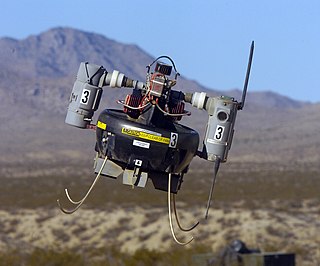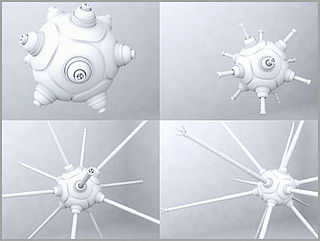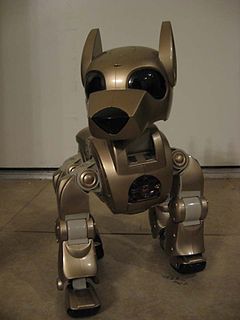Bio-inspired computing, short for biologically inspired computing, is a field of study that loosely knits together subfields related to the topics of connectionism, social behaviour and emergence. It is often closely related to the field of artificial intelligence, as many of its pursuits can be linked to machine learning. It relies heavily on the fields of biology, computer science and mathematics. Briefly put, it is the use of computers to model the living phenomena, and simultaneously the study of life to improve the usage of computers. Biologically inspired computing is a major subset of natural computation.

A micro air vehicle (MAV), or micro aerial vehicle, is a class of miniature UAVs that has a size restriction and may be autonomous. Modern craft can be as small as 5 centimeters. Development is driven by commercial, research, government, and military purposes; with insect-sized aircraft reportedly expected in the future. The small craft allows remote observation of hazardous environments inaccessible to ground vehicles. MAVs have been built for hobby purposes, such as aerial robotics contests and aerial photography.

Utility fog is a hypothetical collection of tiny robots that can replicate a physical structure. As such, it is a form of self-reconfiguring modular robotics.

In computer science and operations research, the ant colony optimization algorithm (ACO) is a probabilistic technique for solving computational problems which can be reduced to finding good paths through graphs. Artificial Ants stand for multi-agent methods inspired by the behavior of real ants. The pheromone-based communication of biological ants is often the predominant paradigm used. Combinations of Artificial Ants and local search algorithms have become a method of choice for numerous optimization tasks involving some sort of graph, e.g., vehicle routing and internet routing. The burgeoning activity in this field has led to conferences dedicated solely to Artificial Ants, and to numerous commercial applications by specialized companies such as AntOptima.

Fast Light Toolkit is a cross-platform widget library for graphical user interfaces (GUIs), developed by Bill Spitzak and others. Made to accommodate 3D graphics programming, it has an interface to OpenGL, but it is also suitable for general GUI programming.
Smartdust is a system of many tiny microelectromechanical systems (MEMS) such as sensors, robots, or other devices, that can detect, for example, light, temperature, vibration, magnetism, or chemicals. They are usually operated on a computer network wirelessly and are distributed over some area to perform tasks, usually sensing through radio-frequency identification. Without an antenna of much greater size the range of tiny smart dust communication devices is measured in a few millimeters and they may be vulnerable to electromagnetic disablement and destruction by microwave exposure.
Claytronics is an abstract future concept that combines nanoscale robotics and computer science to create individual nanometer-scale computers called claytronic atoms, or catoms, which can interact with each other to form tangible 3D objects that a user can interact with. This idea is more broadly referred to as programmable matter. Claytronics has the potential to greatly affect many areas of daily life, such as telecommunication, human-computer interfaces, and entertainment.

Pilotfish is a multidisciplinary design and innovation consultancy with offices in Amsterdam, Munich, and Taipei. The company is specialized in industrial design, user interface design, and mechanical engineering. The company covers the entire product development process from research and strategy to ideation, design, engineering, sourcing, tooling, and production.

i-Cybie (爱赛比) is a robotic pet that resembles a dog. It was manufactured by Silverlit Toys Manufactory Ltd Hong Kong from 2000 to 2006. i-Cybie was developed for commercial distribution by Tiger Electronics. Outrageous International Hong Kong distributed the electronic pet from 2005 to 2006. The i-Cybie robotic dog responds to sound, touch, movement, and voice commands. The toy robot can autonomously recharge its batteries using a special docking station. I-Cybie was the first mass-produced toy that used advanced voice recognition technology.
Modular self-reconfiguring robotic systems or self-reconfigurable modular robots are autonomous kinematic machines with variable morphology. Beyond conventional actuation, sensing and control typically found in fixed-morphology robots, self-reconfiguring robots are also able to deliberately change their own shape by rearranging the connectivity of their parts, in order to adapt to new circumstances, perform new tasks, or recover from damage.

Symbrion is a project funded by the European Commission between 2008 - 2013 to develop a framework in which a homogeneous swarm of miniature interdependent robots can co-assemble into a larger robotic organism to gain problem-solving momentum.
In 1995, professor Massimo Grattarola of the Biophysics and Electrical Engineering Department (DIBE) at the University of Genoa, in Genoa, Italy, created an undergraduate and graduate program named neurobioengineering. The program was designed to amalgamate anthropomorphic robotics, artificial intelligence, bioelectronics, electrical engineering, molecular biology, physics, and medicine, into a single program with the aim of developing advanced bio-compatible neuro-prosthetic implants for a variety applications.
Kalin Lindena is a German artist.

Wilesco is the trade name of German toy company Wilhelm Schröder GmbH & Co. KG, known for manufacturing live steam toys such as steamrollers, traction engines, and stationary steam engines.

DARWIN-OP which stands for Dynamic Anthropomorphic Robot with Intelligence–Open Platform is a miniature-humanoid robot platform with advanced computational power, sophisticated sensors, high payload capacity, and dynamic motion ability developed and manufactured by Korean robot manufacturer Robotis in collaboration with Virginia Tech, Purdue University,and University of Pennsylvania. DARWIN-OP has twenty degrees of freedom [20 DOF] each controlled by a DYNAMIXEL MX-28T servo motor. The MX-28T has a stall torque of 24 kgf·cm and a 360 degree range of motion.
Intean Poalroath Rongroeurng Ltd.(IPR) is a registered microfinance institution focused on the domestic agricultural sector in Cambodia. IPR is headquartered in Phnom Penh, Cambodia, and operates six branch offices including several service post offices in five provinces: Kandal, Takéo, Pursat, Batdambang, and Banteay Meanchey. The Company provides credit to farmers living in rural areas that are engaged in the production of rice, cassava, maize, sesame, and other agricultural related enterprises. As of March 31, 2012, IPR manages the 12th largest loan portfolio among registered micro-finance institutions in Cambodia.

RoboBee is a tiny robot capable of partially untethered flight, developed by a research robotics team at Harvard University. The culmination of twelve years of research, RoboBee solved two key technical challenges of micro-robotics. Engineers invented a process inspired by pop-up books that allowed them to build on a sub-millimeter scale precisely and efficiently. To achieve flight, they created artificial muscles capable of beating the wings 120 times per second.
Christopher Csíkszentmihályi is an American artist and technologist. He is the European Research Area Chair of Human-Computer Interaction and Design Innovation at Madeira Interactive Technologies Institute.
Swarm robotic platforms apply swarm robotics in multi-robot collaboration. They take inspiration from nature. The main goal is to control a large number of robots to accomplish a common task/problem. Hardware limitation and cost of robot platforms limit current research in swarm robotics to mostly performed by simulation software. On the other hand, simulation of swarm scenarios that needs large numbers of agents is extremely complex and often inaccurate due to poor modelling of external conditions and limitation of computation.














